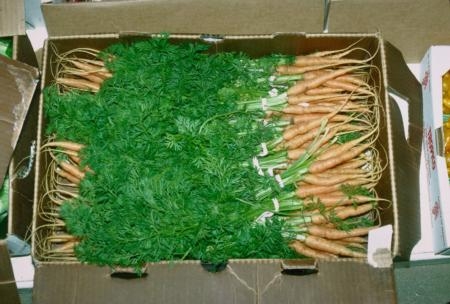
The scientists working in USDA’s carrot breeding program, embedded at the University of Wisconsin, Madison, realized long ago that the Southern California desert agriculture research facility has the ideal climate and soil to grow their experimental hybrids through the winter months.
Each spring, the scientists gather for a tasting. The carrots grown in DREC’s fields are then shipped to Wisconsin, where they will be planted to produce seeds. In the fall, a new batch of seeds will be shipped back to El Centro, where they will be planted, and in turn harvested again sometime in February 2014 for evaluation.
More than 1,000 varieties are grown each year on a one-acre nematode-free section of the research center with silty clay soil. In 88 beds each 120 feet long, a different carrot variety is planted every six feet under the direction of center superintendent Fernando Miramontes.
Over the years, the industry’s carrot preferences have changed. Specific cultivars are grown to create the now ubiquitous baby carrot.
“We grew about 100 varieties for the cut and peel sector of the industry,” said Rob Kane, a University of Wisconsin staff research associate who works with project leader, Phil Simon, UW research geneticist and professor of horticulture. “Farmers want a carrot that is about five-eighths inches in diameter, 14 inches long that they can cut into four pieces to make baby carrots.”
Another part of the trial contains varieties for “cello” carrots, which have different characteristics.
“Cello carrots are wide at the shoulders and taper more,” he said. “Long length doesn’t work for the cello carrots. Refrigerator vegetable drawers aren’t big enough.”
A third part of the trial contains novelty carrots, with cultivars in shades of purple, yellow, red and white.
“These carrots hold promise for juice development,” Kane said. “They can be sources of antioxidants that are said to be cancer preventative. Red carrots have lycopene, yellows have leutien and purple carrots have anthocyanins.”
Size and color are important, but the most significant trait scientists seek is good taste.
“We’re looking for a carrot that is smoother, has better flavor and disease resistance. You never have a complete package,” said Professor Simon recently told the Imperial Valley Press. “It’s crucial to have rich, full flavor. I know it when I taste it.”